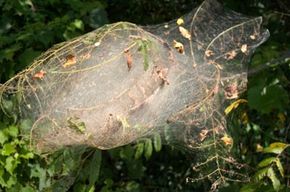Managing Caterpillars
In general, caterpillars are beneficial insects. They become butterflies and moths, which are important pollinators. Butterflies and caterpillars alike are food sources for other animals -- and even for people. Although all species damage plants as they eat, this damage is often minimal, and caterpillars' important role in ecosystems offsets holey, unattractive leaves.
But swarms of gregarious caterpillars can do more harm than good, completely defoliating large swaths of forest. They can cause other problems as well. Gypsy moth caterpillars (Lymantria dispar) can do so much leaf damage that trees eventually die. Eastern tent caterpillars (Malacosoma americanum) have been linked to mare reproductive loss syndrome (MRLS), which causes miscarriages and stillbirths in horses. The hair-like setae of some species can cause allergies and extreme irritation in animals and humans -- sometimes so severe that it requires hospitalization.
Advertisement
In these situations, caterpillar control or extermination can be important. Here's what to keep in mind if you're trying to protect your trees or plants from caterpillar pests:
- In spite if what you may have heard, attempting to burn tents from the trees is not a good idea, particularly in dry conditions. The risk of fire overshadows the immediate extermination of the nest.
- Keep in mind that wasps often prey on caterpillars and keep their population in control. Parasitic wasps will lay their eggs on or in caterpillars, and when these eggs hatch, the larvae will use the caterpillar's body as food. If you exterminate all the wasps in your area, you may inadvertently cause caterpillars to thrive.
- Focus on prevention rather than control. Look for egg masses in the fall. If you see a ring of eggs encircling a tree branch, remove and destroy it before caterpillars hatch.
- If you want to remove tents or nests from your plants, wear gloves -- the caterpillars' hairs can be irritating or cause allergic reactions. If you find that caterpillars' spines have become embedded in your skin, try pulling them out with tape. See a doctor if irritation persists or if you show symptoms of an allergic reaction.
- Use insecticides as a last resort. Often, they're not particularly effective against hungry larvae, although they may kill the adults who are preparing to lay the next generation of eggs. Preparations of the bacterium Bacillus thuringiensis (Bt) will usually control caterpillars, but its effect can be widespread, wiping out beneficial caterpillars as well as pests. Consult your local agricultural extension office or a licensed exterminator to find out which chemicals are recommended and legal in your area.
If you see caterpillars in your yard, keep in mind that only a few species are true pests. Damage from hungry caterpillars, even gregarious species, is usually temporary -- and a yard full of butterflies can be the reward for tolerating it.
To learn more about caterpillars, butterflies and other insects, read through the links below.
Related HowStuffWorks Articles
More Great Links
Sources
- Batzer, Harold O. and Robert C. Morris. "Forest Tent Caterpillar." U.S. Department of Agriculture Forest Service. (4/22/2008) http://www.npwrc.usgs.gov/resource/insects/cateast/families.htm
- Bessin, Ric. "Stinging Caterpillars." University of Kentucky College of Agriculture. 1/2004 (4/22/2008) http://www.ca.uky.edu/entomology/entfacts/ef003.asp
- Blackiston, Douglas J. et al. "Retention of Memory through Metamorphosis: Can a Moth Remember what it Learned as a Caterpillar?" PLoS One. Vol. 3, issue 3. March 2008.
- Collman, Sharon J. "Biology and Control of Tent Caterpillars." Washington State University. (4/22/2008) http://gardening.wsu.edu/library/inse003/inse003.htm
- Despland, Emma and Alice Lee Huu. "Pros and Cons of Group Living in the Forest Tent Caterpillar: Separating the Roles of Silk and Grouping." Entomologia Experimentalis et Applicata. Vol. 122. 2007.
- Gottschling, Sven, M.D. and Sascha Meyer, M.D. "An Epidemic Airborne Disease Caused by the Oak Processionary Caterpillar." Pediatric Dermatology. Vol. 23, no. 1. 2006.
- Miller, Jeffrey C. "Caterpillars of the Pacific Northwest Forests and Woodlands." USGS. 8/24/2006 (4/22/2008) http://www.npwrc.usgs.gov/resource/insects/catnw/morph.htm
- Murawski, Darlyne A. "Killer Caterpillars: Built to Eat Flesh." National Geographic. (4/22/2008) http://ngm.nationalgeographic.com/ngm/0306/feature6/index.html
- Musser, Richard O. et al. "Caterpillar Saliva Beats Plant Defenses." Nature. Vol. 416. 4/11/2002
- Reader, Tom, et al. "Understanding Gregariousness in a Larval Lepidopteran: The Roles of Host Plant, Predation and Microclimate." Ecological Entomology. Vol. 28, 2003.
- Science News. "Ballistic Defecation: hiding, not hygiene." Via Findarticles. 5/3/3003 (4/22/2008) http://findarticles.com/p/articles/mi_m1200/is_18_163/ai_101941097
- Shappert, Phillip J. "A World for Butterflies." Firefly Books. 9/2/2000.
- Shiojiri, Kaori, et al. "Plant Volatiles, Rather than Light, Determine Nocturnal Behavior of a Caterpillar." PLoS Biology.Vol. 4, Issue 6. June 2006.
- Sugiura, Shinji and Kazuo Yamazaki. "The Role of Silk Threads as Lifelines for Caterpillars: Pattern and Significance of Lifeline-climbing Behavior." Ecological Entomology. Vol. 31, 2006.
- Summerville, Keith S. et al. "Community Structure of Arboreal Caterpillars Within and Among Four Tree Species in Eastern Deciduous Forest." Ecological Entomology. Vol. 28, 2003.
- U.S. Geological Service. "Caterpillars of Eastern Forests." (4/22/2008) http://www.npwrc.usgs.gov/resource/insects/cateast/families.htm
- U.S. Geological Service. "Caterpillars of Pacific Northwest Forests and Woodlands." 8/2/3006 (4/22/2008) http://www.npwrc.usgs.gov/resource/insects/catnw/morph.htm
- University of Kentucky College of Agriculture. "Tent Caterpillars Hatch in Central KY." 4/10/2008 (4/22/2008) http://news.bloodhorse.com/viewstory.asp?id=44530
- Willott, Elizabeth. "Insect Physiology." University of Arizona. 1/12/2003 (4/22/2008) http://research.biology.arizona.edu/mosquito/willott/507/anatomy/ manduca/ManAll.html
